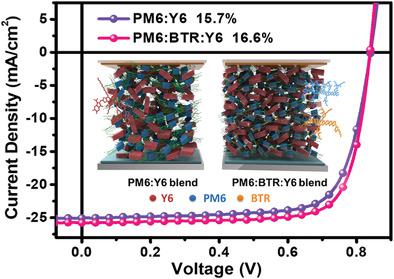Our official English website, www.x-mol.net, welcomes your feedback! (Note: you will need to create a separate account there.)
Synergy of Liquid-Crystalline Small-Molecule and Polymeric Donors Delivers Uncommon Morphology Evolution and 16.6% Efficiency Organic Photovoltaics.
Advanced Science ( IF 15.1 ) Pub Date : 2020-06-18 , DOI: 10.1002/advs.202000149 Cenqi Yan 1, 2 , Hua Tang 1, 2, 3 , Ruijie Ma 4 , Ming Zhang 5 , Tao Liu 4 , Jie Lv 3 , Jiaming Huang 1, 2 , YanKang Yang 5 , Tongle Xu 3 , Zhipeng Kan 3 , He Yan 4 , Feng Liu 5 , Shirong Lu 3 , Gang Li 1, 2
Advanced Science ( IF 15.1 ) Pub Date : 2020-06-18 , DOI: 10.1002/advs.202000149 Cenqi Yan 1, 2 , Hua Tang 1, 2, 3 , Ruijie Ma 4 , Ming Zhang 5 , Tao Liu 4 , Jie Lv 3 , Jiaming Huang 1, 2 , YanKang Yang 5 , Tongle Xu 3 , Zhipeng Kan 3 , He Yan 4 , Feng Liu 5 , Shirong Lu 3 , Gang Li 1, 2
Affiliation

|
Achieving an ideal morphology is an imperative avenue for enhancing key parameters toward high‐performing organic solar cells (OSCs). Among a myriad of morphological‐control methods, the strategy of incorporating a third component with structural similarity and crystallinity difference to construct ternary OSCs has emerged as an effective approach to regulate morphology. A nematic liquid‐crystalline benzodithiophene terthiophene rhodamine (BTR) molecule, which possesses the same alkylthio‐thienyl‐substituted benzo moiety but obviously stronger crystallinity compared to classical medium‐bandgap polymeric donor PM6, is employed as a third component to construct ternary OSCs based on a PM6:BTR:Y6 system. The doping of BTR (5 wt%) is found to be enough to improve the OSC morphology—significantly enhancing the crystallinity of the photoactive layer while slightly reducing the donor/acceptor phase separation scale simultaneously. Rarely is such a morphology evolution reported. It positively affects the electronic properties of the device—prolongs the carrier lifetime, shortens the photocurrent decay time, facilitates exciton dissociation, charge transport, and collection, and ultimately boosts the power conversion efficiency from 15.7% to 16.6%. This result demonstrates that the successful synergy of liquid‐crystalline small‐molecule and polymeric donors delicately adjusts the active‐layer morphology and refines device performance, which brings vibrancy to the OSC research field.
中文翻译:

液晶小分子和聚合物供体的协同作用实现了罕见的形态演化和 16.6% 效率的有机光伏。
实现理想的形貌是提高高性能有机太阳能电池(OSC)关键参数的必要途径。在众多的形态控制方法中,结合具有结构相似性和结晶度差异的第三种成分来构建三元OSC的策略已成为调控形态的有效方法。向列液晶苯并二噻吩三噻吩罗丹明(BTR)分子具有相同的烷硫基噻吩基取代的苯并部分,但与经典的中带隙聚合物供体PM6相比结晶度明显更强,被用作第三组分来构建基于PM6:BTR:Y6 系统。发现 BTR (5 wt%) 的掺杂足以改善 OSC 形态,显着增强光活性层的结晶度,同时略微降低施主/受主相分离规模。很少有这种形态演变的报道。它对器件的电子特性产生积极影响——延长载流子寿命,缩短光电流衰减时间,促进激子解离、电荷传输和收集,最终将功率转换效率从 15.7% 提高到 16.6%。这一结果表明,液晶小分子和聚合物给体的成功协同作用巧妙地调整了活性层形态并改善了器件性能,为OSC研究领域带来了活力。
更新日期:2020-08-05
中文翻译:

液晶小分子和聚合物供体的协同作用实现了罕见的形态演化和 16.6% 效率的有机光伏。
实现理想的形貌是提高高性能有机太阳能电池(OSC)关键参数的必要途径。在众多的形态控制方法中,结合具有结构相似性和结晶度差异的第三种成分来构建三元OSC的策略已成为调控形态的有效方法。向列液晶苯并二噻吩三噻吩罗丹明(BTR)分子具有相同的烷硫基噻吩基取代的苯并部分,但与经典的中带隙聚合物供体PM6相比结晶度明显更强,被用作第三组分来构建基于PM6:BTR:Y6 系统。发现 BTR (5 wt%) 的掺杂足以改善 OSC 形态,显着增强光活性层的结晶度,同时略微降低施主/受主相分离规模。很少有这种形态演变的报道。它对器件的电子特性产生积极影响——延长载流子寿命,缩短光电流衰减时间,促进激子解离、电荷传输和收集,最终将功率转换效率从 15.7% 提高到 16.6%。这一结果表明,液晶小分子和聚合物给体的成功协同作用巧妙地调整了活性层形态并改善了器件性能,为OSC研究领域带来了活力。



























 京公网安备 11010802027423号
京公网安备 11010802027423号